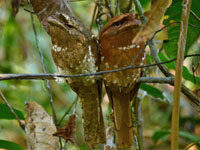The family Podargidae contains the Frogmouths. Their closest relatives are owlet-nightjars of family Aegothelidae and Caprimulgidae. Frogmouths, nightjars, and owlet-nightjars used to be placed in the same order Caprimulgiformes, but DNA evidence suggests they diverged more than 30 million years. The frogmouths are now placed in their own order Podargiformes, owlet-nightjars in Aegotheliformes. and nightjars remain in Caprimulgiformes.
Frogmouths are found in Asia and Australasia. The Asian frogmouths are placed in genus Batrachostomus and the Australasian in Podargus. The Solomon Islands frogmouth is placed in its own genus Rigidipenna. Podargus are the largest birds, in general about twice the size of the Batrachostomus species. The Solomon Islands frogmouth is about about the same size as the largest Batrachostomus which is actually called the large frogmoutn/
The name frogmouth refers to their wide mouth. They have a large flat bill which enables them to catch insects. In addition to insects, some species also catch small mammals such as frogs and mice. They are nocturnal, have large eyes, are well camouflaged, like to rest and sleep horizontally on tree branches, and are are poor fliers.
With their big head and large eyes for night vision, frogmouths also resemble owls in appearance. Like them the frogmouth is relatively silent in flight and has 3 toes facing forward plus one towards the read. Unlike owls, the frogmouth can rotate its eyes so the range of motion of its head is much less than the owl’s. And a frogmouth’s feet are much shorted and weaker that an owl’s that uses the raptor-like claws to catch prey.
Genus Batrachostomus
The Batrachostomusfrogmouth species are found in Southeast Asia including Malaysia, Indonesia, and the Philippines. They range from 20 to a little over 40 cm long. The diet is mainly large insects such as moths, beetles, and grasshoppers. Their nests are made primarily out of their own down plus moss and bark. Many of these species seem to have a threatened population as they are only infrequently seen, but in some cases that could be due to their great camouflage.
Frogmouth,_Blyth's Batrachostomus affinis
Description: The male Blyth's frogmouth has brown upperparts with some white spots showing. The upper-breast is similar to the upperparts. The lower-breast. belly, and under-tail are a mixture of brown and white. He has a white supercilium and hard to see thin white semi-collar on the nape. The female has similar markings except she is more colorful with the brown replaced by rufous-brown. The Blyth's frogmouth is 20 to 23 cm long. Blyth's frogmouth, the Javan frogmouth, and the Palawan frogmouth are sometimes considered to be conspecific. The ranges of the three frogmouths do not overlap. Blyth's frogmouth does overlap with Gould's frogmouth, but has a smaller bill.
Range: Mainland Southeast Asia, Malaysia Peninsular, Borneo, Sumatra.
Habitat: Usually in moist forests, below 1000 meters, and sitting motionless in a tree.
Diet: Insects.
Conservation status: Not listed.
Image by: 1) lonelyshrimpRange: Mainland Southeast Asia, Malaysia Peninsular, Borneo, Sumatra.
Habitat: Usually in moist forests, below 1000 meters, and sitting motionless in a tree.
Diet: Insects.
Conservation status: Not listed.
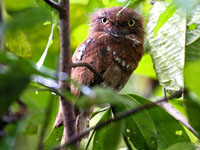
Frogmouth,_Javan Batrachostomus javensis
Description: The male Javan frogmouth has mainly brown upperparts and a breast with white and grey. It has a wide white streak on the scapulars and whitish supercilium. The flanks and belly are paler. Females are tawnier and have less white. The Javan frogmouth is about 22 cm long.
Range: Bali and Java of Indonesia.
Habitat: Montane forests up to 2000 meters.
Diet: Mainly insects such as butterflies, ants, grasshoppers; also snails.
Conservation status: It is listed as Least Concern as there are no known threats.
Image by: 1) Eko_ph 2) Francesco_Veronesi 3) Waskito_kwRange: Bali and Java of Indonesia.
Habitat: Montane forests up to 2000 meters.
Diet: Mainly insects such as butterflies, ants, grasshoppers; also snails.
Conservation status: It is listed as Least Concern as there are no known threats.
1) Pair 2) Female 3) Male



Frogmouth,_Dulit Batrachostomus harterti
Description: The Dulit frogmouth has dark chestnut-brown upperparts with buffy barring on the rear-crown. The dark wing-coverts have large white spots. The underparts paler are with whitish spots on the breast and barring on the under-tail. The Dulit frogmouth is up to 37 cm long.
Range: Northern and central Borneo.
Habitat: Mountain forests.
Diet: Probably insects.
Conservation status: It is listed as Near Threatened because of its small range and little available data.
Image by: 1) John_Gerrard_Keulemans Range: Northern and central Borneo.
Habitat: Mountain forests.
Diet: Probably insects.
Conservation status: It is listed as Near Threatened because of its small range and little available data.
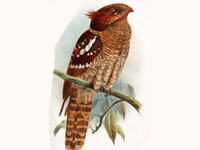
Frogmouth,_Gould's Batrachostomus stellatus
Description: The Gould's frogmouth has brown or dark brown upperparts, depending on the morph. There are white spots on the wings and scapulars and a faint white collar. It has an approximately 1 month incubation period in which both parents participate. The shallow nest is made of branches and lichens and lined with down from the parents. The Gould's frogmouth is 21 to 25 cm long. The similar Blyth's frogmouth has a smaller bill.
Range: Thailand to Malay Peninsular, Borneo. Mainly present in Malaysia and Singapore.
Habitat: Undisturbed tropical rainforest.
Diet: Insects, especially moths, locusts, and beetles.
Conservation status: It is listed as Near Threatened because of habitat destruction.
Image by: 1) Francesco_Veronesi - ThailandRange: Thailand to Malay Peninsular, Borneo. Mainly present in Malaysia and Singapore.
Habitat: Undisturbed tropical rainforest.
Diet: Insects, especially moths, locusts, and beetles.
Conservation status: It is listed as Near Threatened because of habitat destruction.

Frogmouth,_Hodgson's Batrachostomus hodgsoni
Description: The male Hodgson's frogmouth has has rufous brown, white and black plumage. In particular, there are bold patches of white on the upper-mantle and scapulars. The female has more rufous and less white. The Hodgson's frogmouth is 24 to 27 cm long.
Range: China, Indian subcontinent, southeast Asia.
Habitat: Tropical rainforest.
Diet: Mainly large insects such as moths and beetles.
Conservation status: Least Concern.
Image by: 1) lonelyshrimp 2) Tony_Castro - Thailand 3) Amarjyoti_Saikia - India 3) Naturelly Range: China, Indian subcontinent, southeast Asia.
Habitat: Tropical rainforest.
Diet: Mainly large insects such as moths and beetles.
Conservation status: Least Concern.



Frogmouth,_Large Batrachostomus auritus
Description: The large Frogmouth has chestnut and blackish-brown upperparts with some white spots.The underparts are dull brown or pale rufous spotted with white. It is considerably larger compared to the other members of the genus with a length of about 42 cm.
Range: Southeast Asia, especially Borneo.
Habitat: Mainly primary but also secondary lowland forests.
Diet: Large insects such as grasshoppers.
Conservation status: It is listed as Near Threatened because it is rarely seen and the population is probably declining because of habitat destruction.
Image by: 1) LonelyShrimp - Malaysia Con_Foley - Malaysia 2) James_Eaton - Sumatra, IndonesiaRange: Southeast Asia, especially Borneo.
Habitat: Mainly primary but also secondary lowland forests.
Diet: Large insects such as grasshoppers.
Conservation status: It is listed as Near Threatened because it is rarely seen and the population is probably declining because of habitat destruction.


Frogmouth,_Palawan Batrachostomus chaseni
Description: The Palawan frogmouth has mainly rufous or grey plumage. The underparts have a substantial about of white. The different plumages may be morphs or different colors for male and female. The eyes are yellow.
Range: Palawan in the Philippines.
Habitat: Woodlands.
Diet: Large insects.
Conservation status: It is not listed.
Image by: 1) Blake_Matheson 2) Mark_Harper 3) Brendan_Ryan - PalawanRange: Palawan in the Philippines.
Habitat: Woodlands.
Diet: Large insects.
Conservation status: It is not listed.

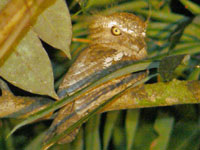

Frogmouth,_Philippine Batrachostomus septimus
Description: The Philippine frogmouth has a rufous morph and a brown morph. Both morphs have a whitish band on the nape and another on the throat. The underparts are paler than the upperparts. There are no other frogmouths in the Philippines. The Philippine nightjar has a similar shape but quite different plumage. The Philippine frogmouth is about 25 cm long.
Range: Philippines.
Habitat: Woodlands.
Diet: Insects.
Conservation status: Least Concern.
Image by: 1) Joseph_Smit 2) Charles_Davies 3) Vinz_PascuaRange: Philippines.
Habitat: Woodlands.
Diet: Insects.
Conservation status: Least Concern.



Frogmouth,_Short-tailed Batrachostomus poliolophus :
Description: The short-tailed frogmouth, also known as the Sumatran frogmouth, has brown upperparts with some white on the scapulars and wings. There is also a thin white collar and pale superciliums. The underparts are lighter brown with many areas of dense white spots. The male's brown has some rufous tinge and the female's a little. The short-tailed frogmouth is so-named because its tail is short for a frogmouth and that contribules to its small size of 20 to 22 cm.
Range: Sumatra (Indonesia)
Habitat: Lowland and montane forests to 1200 meters..
Diet: Large insects such as crickets and beetles..
Conservation status: It is listed as Near Threated because it has a small range and is only rarely seen.
Image by: 1) Seshadri_KS Range: Sumatra (Indonesia)
Habitat: Lowland and montane forests to 1200 meters..
Diet: Large insects such as crickets and beetles..
Conservation status: It is listed as Near Threated because it has a small range and is only rarely seen.
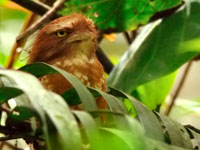
Frogmouth,_Sri_Lanka Batrachostomus moniliger
Description: The male Sri Lanka frogmouth has grey-brown plumage with fine barring and a spotted crown. Some males are browner and more similar to females. The female has rufous or chestnut brown plumage. Som females have black spotting on the crown. They have short, stiff bristles around the eyes. The Sri Lanka frogmouth is up to 23 cm long.
Range: Sri Lanka and the West Ghats region of India.
Habitat: Tropical forests, secondary forests, and sometimes plantations close to towns.
Diet: Insects which it gleans from branches or catch them on the ground and in flight. .
Conservation status: Least Concern.
Image by: 1) Shanthanu_Bhardwaj 2) Arshad.ka5 3) Aaron_Maizlish - IndiaRange: Sri Lanka and the West Ghats region of India.
Habitat: Tropical forests, secondary forests, and sometimes plantations close to towns.
Diet: Insects which it gleans from branches or catch them on the ground and in flight. .
Conservation status: Least Concern.
1) Male left, female right 2) Female 3) Male



Frogmouth,_Sunda Batrachostomus cornutus
Description: The male Sunda frogmouth has has variable plumage from black and whiteto brown and white The female has rufous plumage with some white. Both sexes have pale superciliums. The Sunda frogmouth is up to 28 cm long.
Range:Borneo, Sumtra.
Habitat: Open woodlands, forest edges.
Diet: Large insects.
Conservation status: Least Concern.
Image by: 1) Melindra12 2) David_Cook - BorneoRange:Borneo, Sumtra.
Habitat: Open woodlands, forest edges.
Diet: Large insects.
Conservation status: Least Concern.


Genus Podargus
The Podargus frogmouths are found in Australasia. They are larger than the Batrachostomus frogmouths and have a proportionately larger mouth. Their nests are made out of twigs and sometimes lines with softer material such as moss.
Frogmouth,_Marbled Podargus ocellatus
Description: The male marbled frogmouth has dull grey-brown upperparts (often with marbling and streaking) or deep rufous upperparts (often with very little marbling). The underparts also variable, often with irregular white barring and longitudinal dark streaks. Females are usually darker than males, but the sex can be hard to differentiate. They sleep on a tree branch during the day. The male marbled frogmouth is 40 to 50 cm long.
Range: Queensland (Australia), New Guinea, Solomon Islands.
Habitat: Subtropical rainforest and vineforest at altitudes from 50–800 m. Roosts in the canopy.
Diet: Large insects. It is a nocturnal ground feeder.
Conservation status: Least Concern.
Image by: 1, 2) Katerina_Tvardikova 3) Bauple58Range: Queensland (Australia), New Guinea, Solomon Islands.
Habitat: Subtropical rainforest and vineforest at altitudes from 50–800 m. Roosts in the canopy.
Diet: Large insects. It is a nocturnal ground feeder.
Conservation status: Least Concern.



Frogmouth,_Papuan Podargus papuensis
Description: The Papuan frogmouth has a bulbous bill, red eye with cream colored supercilium, a long tail and dark wings. The male is slightly larger than the female and duller. Her plumage is more rufous. This is the longest frogmouth with an length of 50 to 60 cm.
Range: New Guinea, Northern Australia.
Habitat: Moist lowland forests.
Diet: Mainly large insects which it takes on the ground. Also small vertebrates such as frogs and chicks.
Conservation status: Least Concern.
Image by: 1) David_Cook - Queensland 2) Daderot 3) Graham_Winterflood 4) Jerry_Oldenettel Range: New Guinea, Northern Australia.
Habitat: Moist lowland forests.
Diet: Mainly large insects which it takes on the ground. Also small vertebrates such as frogs and chicks.
Conservation status: Least Concern.

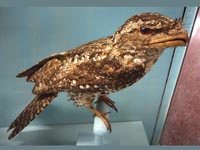
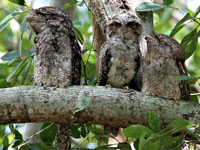

Frogmouth, Tawny Podargus strigoides
Description: The tawny frogmouth has silvery-grey plumage with fine black streaks. The "tawny" refers to the color of its open bill. It has yellow eyes and the wide bill is topped with a tuft of bristly feathers. The tawny frogmouth is up to 53 cm long.
Range: Australia.
Habitat: Forests, scrubland, and more open areas such as parks.
Diet: Insects, but also frogs, worms, snails, small birds, centipedes..
Conservation status: Least Concern.
Image by: 1) Benjamint444 - southeast Asia 2) David Cook - Australia
3) Blueday - Sydney, Australia 4) Charlie Westerinen - Swansea, AustraliaRange: Australia.
Habitat: Forests, scrubland, and more open areas such as parks.
Diet: Insects, but also frogs, worms, snails, small birds, centipedes..
Conservation status: Least Concern.



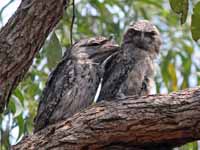
Genus Rigidipenna - 1 species
Frogmouth,_Solomons Rigidipenna inexpectata
Description: The Solomons frogmouth differs in several ways from other frogmouths, for instance in having only eight tail feathers instead of the more usual ten or twelve, and also in having coarser feathers. It has mainly brown upperparts including the head. That brown can have a rufous tinge. The tale and wings have light barring and there are some white spots on the wing-coverts. It has pale superciliums. The underparts are somewhat paler brown and ave many white spots. The Solomons frogmouth is about 37 cm long.
Range: Solomon Islands which are northeast of Australia
Habitat: Woodlands.
Diet: Probably large insects.
Conservation status: It is listed as Near Threatened because of its small range.
Image by: 1) Siddarth_RajRange: Solomon Islands which are northeast of Australia
Habitat: Woodlands.
Diet: Probably large insects.
Conservation status: It is listed as Near Threatened because of its small range.
